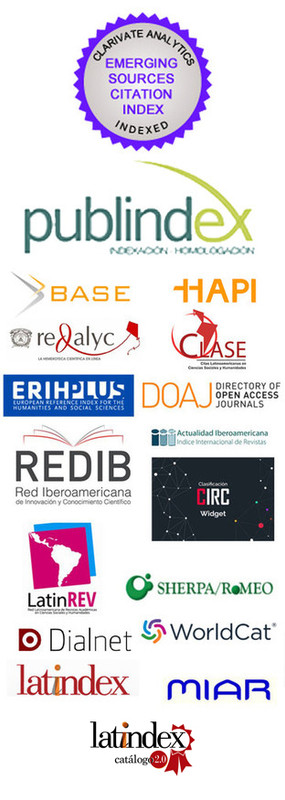
DOI:
https://doi.org/10.14483/21450706.22279Publicado:
2025-07-04Número:
Vol. 20 Núm. 38 (2025): Vol. 20 Núm. 38 (2025): Julio-diciembre 2025Sección:
Sección CentralUrban Encounters: Climate Art and the Public
Encuentros urbanos: el arte climático y el público
Encontros Urbanos: Arte Climática e o Público
Palabras clave:
Arte climático, cambio climático, calentamiento global, arte público, espacio público urbano (es).Palabras clave:
Climate art, climate change; , global warming , public art, public urban space (en).Palabras clave:
Arte climática, mudança climática, aquecimento global, arte pública, , espaço público urbano (pt).Descargas
Resumen (en)
This article examines the importance of public spaces as conduits for communication and education and platforms for spreading awareness of global warming through artistic expression. It explores how these spaces function, the impact of artworks in urban environments, and the role of public art in addressing sustainability issues. By categorizing public spaces into social and quotidian realms, the article highlights their potential as forums for discussion and learning about global issues. The article uses case studies, such as the projects of Daan Roosegaarde and Eve Mosher, to illustrate how climate art engages viewers in contemplating a more sustainable future through emotional and sensory experiences.
Resumen (es)
Este artículo examina la importancia de los espacios públicos como conductos de comunicación y educación, así como plataformas para difundir la concienciación sobre el calentamiento global mediante la expresión artística. Explora las funciones de estos espacios, el impacto de las obras de arte en los entornos urbanos y el papel del arte público a la hora de abordar cuestiones de sostenibilidad. Al clasificar los espacios públicos en ámbitos sociales y cotidianos, el artículo destaca su potencial como foros de debate y aprendizaje sobre cuestiones globales. El artículo utiliza estudios de casos, como los proyectos de Daan Roosegaarde y Eve Mosher, para ilustrar cómo el arte climático involucra a los espectadores en la contemplación de un futuro más sostenible mediante experiencias emocionales y sensoriales.
Resumen (pt)
Este artigo examina a importância dos espaços públicos como canais de comunicação e educação, bem como plataformas para difundir a conscientização sobre o aquecimento global por meio da expressão artística. Ele explora as funções desses espaços, o impacto das obras de arte nos ambientes urbanos e o papel da arte pública na abordagem de questões de sustentabilidade. Ao classificar os espaços públicos em domínios sociais e cotidianos, o artigo destaca seu potencial como fóruns de debate e aprendizado sobre questões globais. O artigo usa estudos de caso, como os projetos de Daan Roosegaarde e Eve Mosher, para ilustrar como a arte climática envolve os espectadores na contemplação de um futuro mais sustentável por meio de experiências emocionais e sensoriais
Referencias
Abbasia, A., Alalouchb, C., & Bramleyc, G. (2016). Open space quality in deprived urban areas: User perspective and use pattern. Procedia - Social and Behavioral Sciences, 216, 194-205. https://doi.org/10.1016/j.sbspro.2015.12.028
Aldredge, M. A. (2012, November 16). A line made by flooding-artist Eve Mosher: I never wanted to be right. Gwarlingo. https://gwarlingo.com/2012/a-line-made-by-flooding-artist-eve-mosher-i-never-wanted-to-be-right/
Altman, I., & Zube, E. (1989). Public Places and Spaces. Plenum Press.
Atmodiwirjo, P., & Yatmo, Y. A. (2019). Interiority in Everyday Space: A Dialogue between Materiality and Occupation. Interiority, 2(1), 1-4. https://doi.org/10.7454/in.v2i1.56
Brenthel, A. (2016). The Drowning World: The Visual Culture of Climate Change. Lund University. https://lucris.lub.lu.se/ws/portalfiles/portal/7501416/Brenthel_The_Drowning_World.pdf
Brighenti, A. M. (2010) The Publicness of Public Space: On the Public Domain. Università di Trento. https://core.ac.uk/download/pdf/11830069.pdf
Buckland, D. (2013). Climate is Culture. En International Social Science Council, World Social Science Report 2013: Changing Global Environments (pp. 365-367). UNESCO Publishing. https://doi.org/10.1787/9789264203419-en
Carr, S., Francis, M., Rivlin, L. G., & Stone, A. M. (1992). Public Space. Cambridge University Press.
Denchak, M. (2017, July 17). How you can stop global warming. NRDC. https://www.nrdc.org/stories/how-you-can-stop-global-warming
Dewey, J. (2005). Art as Experience. Perigee Book.
Doan, A. (2013, November 26) HighWaterLine: Visualizing climate change with artist Eve Mosher. The Wild Magazine. https://web.archive.org/web/20140131031911/http://thewildmagazine.com/blog/highwaterline-visualizing-climate-change-with-artist-eve-mosher/
Francis, M. (1989). Control as a dimension of public-space quality. In I. Altman & E. Zube (Eds.), Public Places and Spaces (pp. 147-172). Plenum Press. https://doi.org/10.1007/978-1-4684-5601-1_7
Frasz, A. (2016). Can art change how we think about climate change: An interview with Anthony Leiserowitz. GIA Reader, 27(3). https://www.giarts.org/article/can-art-change-how-we-think-about-climate-change
Galafassi, D., Kagan, S., Milkoreti, M., Heras, M., Bilodeau, C., Bourke, S. J., Merrie, A., Guerrero, L., Pétursdóttir, G., Tàbara, J. D. (2018). ‘Raising the temperature’: the arts in a warming planet. Current Opinion in Environmental Sustainability, 31, 71-79. https://doi.org/10.1016/j.cosust.2017.12.010
Gehl, J. (2012). Life Between Buildings: Using Public Space. Island Press.
Grodach, C. (2010). Art spaces, public space, and the link to community development. Community Development Journal, 45(4), 474-493. https://doi.org/10.1093/cdj/bsp018
Habermas, J. (2020). The Structural Transformation of the Public Sphere: An Inquiry into a Category of Bourgeois Society. Polity Press.
Habermas, J., Lennox, S., & Lennox, F. (1974). The public sphere: An encyclopedia article (1964). New German Critique, (3), 49-55. https://doi.org/10.2307/487737
Hahn, U. (2023). Artistic Imaginations of Climate Change: From the Far Away to the Here and Now. Environmental Justice, 16(3), 186-193. https://doi.org/10.1089/env.2022.0063
HighWaterLine | Miami. (n.d.). Urban Impact Lab. https://www.urbanimpactlab.com/our-work/highwater-line
HighWaterLine. (n.d.). Creative Carbon Scotland. https://www.creativecarbonscotland.com/library/highwaterline/
Jalaladdini, S., & Oktay, D. (2012). Urban Public Spaces and Vitality: A Socio-Spatial Analysis in the Streets of Cypriot Towns. Procedia - Social and Behavioral Sciences, 35, 664-674. https://doi.org/10.1016/j.sbspro.2012.02.135
Kagan, S. (2014, February 15). La pratique de l’art écologique. Plastik. https://plastik.univ-paris1.fr/la-pratique-de-lart-ecologique/
Kaufmann, D. B., Palawat, K., Sandhaus, S., Buxner, S., McMahon, E., & Ramírez-Andreotta, M. D. (2023). Communicating environmental data through art: the role of emotion and memory in evoking environmental action. Humanities and Social Sciences Communications, 10(940). https://doi.org/10.1057/s41599-023-02459-3
Kirby, L. (n.d.). Public Engagement on Climate Change through Waterlicht. Urban Water TMU. https://www.torontomu.ca/water/freshwater-science---governance/outreach/climate-change-education/
Kohn, M. (2008). Homo spectator: public space in the age of spectacle. Philosophy & Social Criticism, 34(5), 467-486. https://doi.org/10.1177/0191453708089194
Kolbert, E. (2012, November 4). Crossing the line. The New Yorker. https://www.newyorker.com/magazine/2012/11/12/crossing-the-line-3
Latané, B., & Liu, James H. (2006). The Intersubjective Geometry of Social Space. Journal of Communication, 46(4), 26-34. https://doi.org/10.1111/j.1460-2466.1996.tb01502.x
Lesen, A. E., Rogan, A., & Blum, M. J. (2016). Science communication through art: Objectives, challenges, and outcomes. Trends in Ecology & Evolution, 31(9), 657-660. https://doi.org/10.1016/j.tree.2016.06.004
Low, S. (2022, November 17). What is public space?. OUP Academic. https://doi.org/10.1093/oso/9780197543733.003.0002
Lubenow, J. A. (2012). Public Sphere and Deliberative Democracy in Jürgen Habermas: Theorethical Model and Critical Discourses. American Journal of Sociological Research, 2(4), 58-71. doi: 10.5923/j.sociology.20120204.02
Lubenow, J. A. (2012). The Public Sphere 50 Years Later: Public Sphere and Mass Media in Jürgen Habermas. Revista Transformação, 35(3), 189-220.
McCright, A. M., & Dunlap, R. E. (2000). Challenging Global Warming as a Social Problem: An Analysis of the Conservative Movement's Counter-Claims. Social Problems, 47(4), 499-522. https://doi.org/10.2307/3097132
McKibben, B. (2005, April 22). What the warming world needs now is art, sweet art. Grist. https://grist.org/article/mckibben-imagine/
Mosher, E. (n.d.). Eve Mosher. https://www.evemosher.com/
Nadir, L. C. (2015). Walking the edge of the Earth. American Scientist, 103(2), 110-113. https://doi.org/10.1511/2015.113.110
Nadir, L. C. (2015). Walking the Edge of the Earth: Eve Mosher's High Water Line Takes Climate Science to the Streets. American Scientist, 103, 110-113.
Pugh, K. J., & Girod, M. (2007). Science, art and experience: Constructing a science pedagogy from Dewey’s aesthetics. Journal of Science Teacher Education, 18, 9-27. https://doi.org/10.1007/s10972-006-9029-0
Quito, A. (2018, March 24). A spectacularly foreboding light show calls for UN leaders to act on rising sea levels. Quartz. https://qz.com/quartzy/1236577/a-spectacularly-foreboding-light-show-calls-for-un-leaders-to-act-on-rising-sea-levels
Reis, R. (2010). Public art as an educational resource. International Journal of Education Through Art, 6(1), 85-96. https://doi.org/10.1386/eta.6.1.85_1
Rice, R.E., Rebich-Hespanha, S., & Zhu, H. (2019). “Communicating about Climate Change Through Art and Science.” In J. Pinto, R. E. Gutsche, & P. Prado (Eds.) Climate Change, Media & Culture: Critical Issues in Global Environmental Communication (pp. 129-154). Emerald Publishing Limited. https://doi.org/10.1108/978-1-78769-967-020191010
Roosegaarde, D. (n.d.). Waterlicht. Studio Roosegaarde. https://www.studioroosegaarde.net/project/waterlicht
Schuermans, N., Loopmans, M. P. J., & Vandenabeele, J. (2012). Public space, public art and public pedagogy. Social & Cultural Geography, 13, 675-682. https://doi.org/10.1080/14649365.2012.728007
Sensing Change: HighWaterLine. (n.d.). Science History Institute. https://www.sciencehistory.org/sensing-change-highwaterline/
Sommer, L. K., Swim, J. K., Keller, A., & Klöckner, C. C. (2019). Pollution pods: The merging of art and psychology to engage the public in climate change. Global Environmental Change, 59. 101992. https://doi.org/10.1016/j.gloenvcha.2019.101992
Springett, S. (2022). Art-making for political ecology: practice, poetics and activism through enchantment. Continuum, 36(3), 478-494. https://doi.org/10.1080/10304312.2021.2020725
Studio roosegaarde. (2022). Waterlicht: a dream landscape about the power and poetry of water by Roosegaarde [Official Movie 2022] [Video]. Vimeo. https://vimeo.com/687925832
The Glasgow School of Art. (2013). Hayley Newman, “Performing Performance” [Video]. Vimeo. https://vimeo.com/60546256
Tsui, D. (2020, February 12). Are Art Exhibition on climate change harmful or helpful? CoBo Social. https://www.cobosocial.com/dossiers/art-exhibitions-on-climate-change/
Waterlicht in Museumpark trekt 25 duizend bezoekers. (2021, December 20). Actueel nieuws, sport en achtergronden - Rijnmond. https://www.rijnmond.nl/nieuws/174467/waterlicht-in-museumpark-trekt-25-duizend-bezoekers
Wees, N. (2022, May 8). The Arts of the Street: Sense Perception, Creativity and Resistance in Everyday Urban Life [Doctoral Thesis, University of Western Ontario]. Electronic Thesis and Dissertation Repository. https://ir.lib.uwo.ca/etd/8689
Cómo citar
APA
ACM
ACS
ABNT
Chicago
Harvard
IEEE
MLA
Turabian
Vancouver
Descargar cita
Licencia
Derechos de autor 2025 Mei-Hsin Chen

Esta obra está bajo una licencia internacional Creative Commons Atribución-NoComercial-CompartirIgual 4.0.
Licencia actual vigente
Creative Commons BY NC SA - Atribución – No comercial – Compartir igual. Vigente a partir del Vol. 17 No. 32: (julio-diciembre) de 2022.
This work is licensed under a https://creativecommons.org/licenses/by-nc-sa/4.0/deed.es
Licencias anteriores
- Desde el Vol. 14 Núm. 25 (2019) hasta el Vol. 17 Núm. 31: enero-junio de 2022 se utilizó la licencia Creative Commons BY NC ND https://creativecommons.org/licenses/by-nc-nd/4.0/deed.es
- Desde el Vol 1 Num 1 (2007) hasta el Vol. 13 Núm. 23 (2018) la licencia fue Creative Commons fue Reconocimiento- Nocomercial-Sin obras derivadas 2.5 Colombia https://creativecommons.org/licenses/by/2.5/co/












